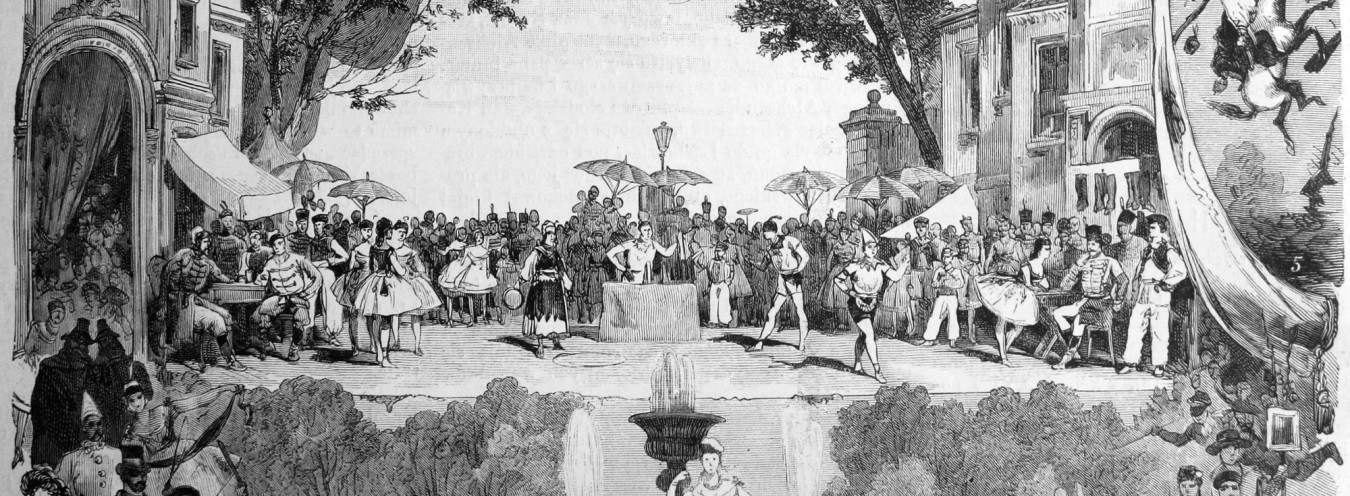
Ballet
[A barber to Wokulski:] I know several ballet girls who’d be delighted to enter relations with you, sir. It would be worthwhile, upon my word! Splendidly built, muscles like iron, bosoms like spring mattresses, ever so graceful and not at all stuck-up, particularly when they’re still young. (225)
Polish ballet experienced considerable growth between 1840 and 1880. In 1869, the position of the ballet director was entrusted to Virgilius Calori, an Italian ballet master from Vienna. His magical ballet production Flick i Flock (Flick and Flock), staged in 1869 to a libretto by Filippo Taglioni, featured a traditional dance from the Polish Masovia – mazur – so exquisitely choreographed that the enraptured audience could not stop calling for encores. Russian authorities interpreted that behaviour as a demonstration of national pride, and it ended in multiple arrests and an official ban on encoring. Calori’s next success was fantasy ballet Pan Tadeusz (1874), much censored by the Russians, based on the same-titled Polish national epic. On Calori’s death in 1875, the running of the Warsaw Ballet passed to Pasquale Borri. His greatest success was the fine, intricate staging of The Goddess of Valhalla. In 1879, Borri was succeeded by Jose Mendez, Taglioni’s pupil and representative of the Italo-Spanish school of ballet. At that time, the internationally acclaimed Helena Cholewicka often performed as the Prima Ballerina Absoluta of the Warsaw Ballet, and Aleksander Gilbert distinguished himself in lover roles (a fellow-dancer, Paweł Owerłło, claimed that Gilbert’s style stood out for his outstanding grace and charm).
An immense demand for national-themed performances was confirmed by the massive popularity of Pan Twardowski, a ballet based on an exclusively Polish story and motifs. This is how the performance was reviewed by Fritz Wernick, a German chronicler who visited Warsaw in 1876: The ballet scenery and arrangement are excellent and infinitely tasteful. The Polish national dances – vibrant, colourful, kindling sparks are most memorable. Mazurkas, cracoviennes and obereks seem to electrify black-eyed girls and nimble boys, who throw back the loose untied sleeves of their white Kontusz robes and continue with their brisk lively steps at a dizzying tempo. These wonderful dances truly thrill the audience.
Wernick’s enthusiasm might have been genuine, but it must be said that Warsaw’s ballet repertoire was rather limited, with only one Opera Theatre premiere a year. Well-directed productions, with impressive scenery sets and meticulous execution, were adequately appreciated and met with success. Still, performances were few in number and based on foreign works while Polish artists – often distinguished – were busy earning their fame abroad.
In Prus’s novel, there is only one reference to ballet, or rather ballet girls (quoted at the beginning of this entry); at the time when ladies’ skirts had to be ankle-length, female ballet outfits must have been a true attraction.
Bibliografia
Fritza Wernicka opis Warszawy z 1876 roku cz. II (Życie), trans. and annotated by I. and J. Kosim, in Warsaw XIX wieku (1795-1918), vol. 2, Warsaw 1971.
T. Sivert, Teatry warszawskie w latach 1865-1890, in Teatr polski od 1863 r. do schyłku XIX wieku, ed. T. Sivert, Warsaw 1982.



